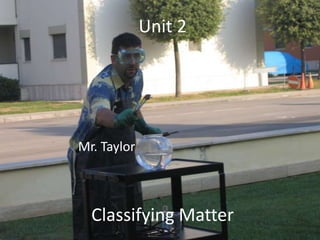
Unit 2 Classifying Matter
- 1. Unit 2 Mr. Taylor Classifying Matter
- 2. What is Matter Made Of? Protons: + charge, 1 AMU, in nucleus Neutrons: neutral charge, 1 AMU, in nucleus Electrons: - charge, 1/1000th AMU, electron cloud The number of protons decides the element number. The number of electrons decides the ionic/oxidation state. The number of neutrons decides the isotope
- 3. Elements An element is the most basic form of matter. It is defined by the number of protons. Usually, the number protons and the number of electrons are equal.
- 4. Atomic Number is the number of Protons Atomic Mass is Protons and Neutrons together
- 5. Elements An element is the most basic form of matter. It is defined by the number of protons. Usually, the number protons and the number of electrons are equal. Secret Question #1: Which element is this?
- 6. Isotopes Isotopes are variations on elements, where the number of neutrons is different. Since neutrons are neutral in charge, they do not affect the properties of the element, only the weight. This isotope is Lithium-7 It has 3 protons and 4 neutrons. If it only had 3 neutrons, it would be Lithium-6
- 7. Atomic Number is the number of Protons Atomic Mass is Protons and Neutrons together
- 8. Most Elements Do NOT Occur in the Pure Form
- 10. Molecule A molecule consists of two or more atoms. They can be the same element (N2) Or different elements. CO – carbon monoxide C2H4 – ethylene C6H12O6 - glucose
- 11. Proteins are HUGE Molecules
- 12. Compounds Compounds contain two or more elements.
- 13. Compounds water (dihydrogenoxide) salt (sodium chloride) ammonia (NH4) rust (iron oxide) chalk (calcium carbonate) sugar (glucose)
- 14. Elements Elements have only ______ type of atom Elements are defined by the number of ______. The whole universe is made from about _____ different elements. The most common element in the universe is __________. *If you are watching by recording, send me these sentences with the answers*
- 15. Compounds Most elements do ____ exist on their own They join with other ___________ to form ____________ . Compounds may have __________ different types of elements in them. *If you are watching by recording, send me these sentences with the answers*
- 16. Mixtures Homogeneous or Heterogeneous? If it is distributed equally it is homogenous. If it separates into layers, it is heterogeneous Colloids are suspended mixtures that do not separate. Milk is an example. Otherwise, over time the layers will separate, such as mud in a lake.
- 17. Solution A solution involves a reaction between molecules due to electromagnetic charges. Solutions are by definition transparent.
- 18. Precipitate A precipitate are solids that form during a chemical reaction between two solutions.
- 19. Mixtures Iron and Sulfur powder in a the mixture So, it is hypothesis time: How can we separate the iron from the sulfur? Enter some ideas in the chat box.
- 20. Mixtures Iron and sulphur – the mixture How can we separate the iron from the sulphur? Use a magnet! Iron is magnetic, sulfur is not...
- 21. Turning an iron-sulphur mixture into a Compound Heat Fe + S FeS Compounds form as a result of chemical reactions
- 22. When iron and sulfur react + sulfur(S) atoms iron (Fe) atoms
- 23. When iron and sulfur react + sulfur(S) atoms iron (Fe) atoms iron sulfide(FeS) molecules
- 24. Differences between compounds and mixtures MIXTURES COMPOUNDS Mixtures can be separated easily Compounds can not be separated
- 25. Differences between compounds and mixtures MIXTURES COMPOUNDS Mixtures can be separated easily Mixture have the properties of the substances present in it Compounds can not be separated Compounds do not have the properties of the elements
- 26. Differences between compounds and mixtures MIXTURES COMPOUNDS Mixtures can be separated easily Mixture have the properties of the substances present in it No chemical change takes place when a mixture is made Compounds can not be separated Compounds do not have the properties of the elements A compound is always formed due to a chemical reaction
- 27. Differences between compounds and mixtures MIXTURES COMPOUNDS Mixtures can be separated easily Mixture have the properties of the substances present in it No chemical change takes place when a mixture is made There is no heat taken in or given out when a mixture is made Compounds can not be separated Compounds do not have the properties of the elements A compound is always formed due to a chemical reaction Heat is either taken in or given out when a compound is made
- 28. Differences between compounds and mixtures MIXTURES COMPOUNDS Mixtures can be separated easily Mixture have the properties of the substances present in it No chemical change takes place when a mixture is made There is no heat taken in or given out when a mixture is made A mixture can contain elements in any proportion Compounds can not be separated Compounds do not have the properties of the elements A compound is always formed due to a chemical reaction Heat is either taken in or given out when a compound is made A compound always contains the elements in fixed proportions, e.g. FeS contains 7g of iron to 4g of sulphur
